The internationally renowned nineteenth century composer is much loved and is an ambassador of the city around the world. From the centre of Lower Bergamo to the heart of the Upper Town, there are testimonies of the life and works of the Maestro everywhere.
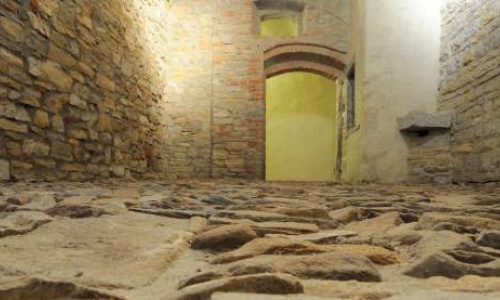
Bergamo’s heart beats for Gaetano Donizetti: the majestic Theatre, named after him since 1897, and the monument dedicated to him clearly show the city’s love. With bus Number 1 to Colle Aperto or on foot via the stairs next to the funicular, and then following via Tre Armi, you reach Borgo Canale. Here, you’ll find Donizetti’s childhood home. Ask for headphones at the entrance and listen to the Maestro’ voice telling of his family’s daily life. Continuing to Via Colleoni, enter the splendid Teatro Sociale, where Donizetti made his debut and that is now the tourist information office as well as for the office for the programing of the Donizetti Opera festival.
Bergamo’s heart beats for Gaetano Donizetti: the majestic Theatre, named after him since 1897, and the monument dedicated to him clearly show the city’s love. With bus Number 1 to Colle Aperto or on foot via the stairs next to the funicular, and then following via Tre Armi, you reach Borgo Canale. Here, you’ll find Donizetti’s childhood home. Ask for headphones at the entrance and listen to the Maestro’ voice telling of his family’s daily life. Continuing to Via Colleoni, enter the splendid Teatro Sociale, where Donizetti made his debut and that is now the tourist information office as well as for the office for the programing of the Donizetti Opera festival.
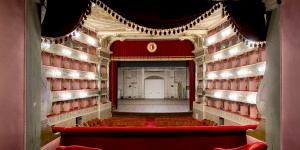
The Teatro Donizetti covers a total area of 3200 square meters. The hall’s dimensions respect the original 1786 design: it measures 360 square meters and it’s able to seat 532 people. There are 120 boxes, divided into three tiers, totalling 1154 seats.
It’s easy to understand how magnificent this building is and how astonished the Bergamo citizens were as they saw it, in an age when there only were small and temporary wooden theatres.
An enormous and sparkling chandelier, with 78 lamps, hangs from the middle of the ceiling, while other sources light up the stage.
Due to its sound harmony and distribution, the theatre is considered one of the best ones in Italy.
Originally named “Riccardi” after its maker, this Theatre is mostly renown as the place where Donizetti’s operas (more than 70!) were spread and appreciated by his fellow citizens.
Try to imagine the emotion experienced by Donizetti in theatre, when the audience assisting to the opera “L’esule di Roma – The exile from Rome”, gave a sincere and warm ovation. This happened in 1840: Donizetti would eventually die of disease in Bergamo a few years later, in his hometown, in 1848.
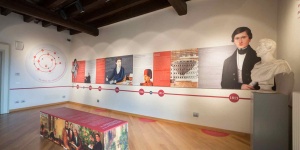
With these words, one of the 5 most famous music composers of all times described his family’s first house, in a letter he wrote to Simone Mayr.
Donizetti’s birthplace, a national historic site, is here in Bergamo, in via Borgo Canale, where buildings used to be extremely poor and crumbling.
His family lived in the basement of a building whose ground floor can also be visited today, where you entered by means of a narrow staircase. It was a very humble house, consisting of two rooms - kitchen and bedroom - along with a well and an icehouse.
It seems that Donizetti’s destiny was written in the stars: over his life, he interlaced music notes creating immortal compositions, just like his parents used to intertwine fabrics. In fact, the Master’s parents were both tailors and were part of that humble people earning their living by working for the noblemen of the Upper Town. Donizetti managed to redeem its humble beginnings becoming famous all over the world and bringing prestige to his city.
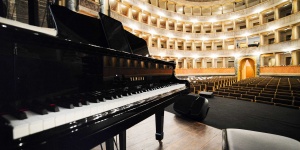
There is no porch or colonnade at the entrance of the Teatro Sociale, because the street is too narrow: nevertheless, this place is extremely surprising. Once you stepped in, you enter a magical, cosy and refined setting, warmed by the wooden balustrades and the beams of the ceiling.
The boxes’ vertical layout features three orders plus a fourth gallery, visually representing the old hierarchical groups.
The architect Leonardo Pollack was asked to design this kind of structure by the aristocratic sponsors of the theatre, as to underline the class differences of that time. In fact, the “Teatro della Società” (“Theatre of Society”), as it was originally called, was born to face a challenge: containing the constant and relentless loss of prestige of Città Alta – the Upper Town – in the favour of the Lower Bergamo’s districts.
Despite its splendour, the theatre presence wasn’t enough to reverse the course of history.
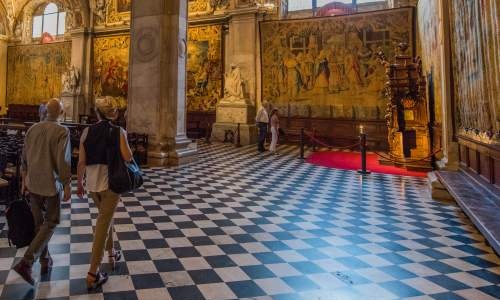
Continue on via Colleoni and on the left you will see a large, white, neoclassical building, it is Palazzo Nuovo (New Palace), which houses the Mai Library. Among its treasures is the handwritten score of Donizetti's Lucia di Lammermoor. Cross the beautiful Piazza Vecchia and continue towards Piazza Duomo. You will find yourself in front of the Santa Maria Maggiore Basilica, the jewel of Bergamo. Inside, visit Gaetano Donizetti’s tomb, adorned with 7 bas-relief cherubs, symbolising the 7 musical notes. Not far away is Palazzo Scotti, where the Maestro ended his days.
Continue on via Colleoni and on the left you will see a large, white, neoclassical building, it is Palazzo Nuovo (New Palace), which houses the Mai Library. Among its treasures is the handwritten score of Donizetti's Lucia di Lammermoor. Cross the beautiful Piazza Vecchia and continue towards Piazza Duomo. You will find yourself in front of the Santa Maria Maggiore Basilica, the jewel of Bergamo. Inside, visit Gaetano Donizetti’s tomb, adorned with 7 bas-relief cherubs, symbolising the 7 musical notes. Not far away is Palazzo Scotti, where the Maestro ended his days.
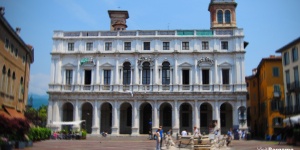
Palazzo Nuovo (“New Palace”) is like a theatre wing located in via Colleoni, overlooking the Piazza Vecchia. It’s called like that in contrast with Palazzo Vecchio (“Old Palace”) aka Palazzo della Ragione, standing in the opposite side of the square.
It took three centuries to build it: the works started in 1604 and ended in 1928. The Palace has served as Bergamo’s Town Hall for three hundred years, till 1873.
Since 1928, one of its rooms has been hosting one of Italy’s most renowned libraries, the “Civica Angelo Mai”, safeguarding parchments, incunabula, codices and precious music sheets.
Inside the Tassiana Hall, you can admire the wonderful globes by Vincenzo Maria Coronelli, cosmographer of the Venice Republic. Dating back to 1688 and 1692, they feature a 3 m circumference and are made of 50 illustrated sheets. Take a look at them: are they really different from today’s ones?
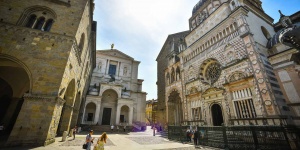
There’s a deep and old connection between the city and Santa Maria Maggiore Basilica, maybe due to the peculiar circumstances of its construction. During the first years of 1100, a terrible plague breakout spread across Europe, causing death and desolation. That’s why the people of Bergamo decided to ask the Virgin Mary to assist them: they vowed to dedicate a church to Her if she had protected them from being infected. Being men of their word, in 1137 Bergamo’s citizens started to built the Santa Maria Maggiore Basilica on the Piazza del Duomo, in the Upper Town. They actually acted big: the church turned out to be really beautiful, and it was adorned even more in the following centuries. Frescoes, stuccos, tapestries and wooden marquetry designed by the renowned artist Lorenzo Lotto decorate the inside of the building.
Santa Maria Maggiore also houses the funerary monument dedicated to Gaetano Donizetti, the famous music composer, symbol and representative of Bergamo all over the world.
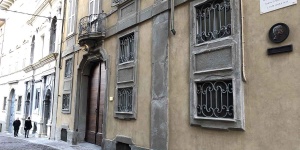
In the street named after maestro Gaetano Donizetti, stands the building where he spent the last days of his life: Palazzo Scotti. The rooms that hosted Donizetti are located on the first floor and are frescoed with neoclassical style works by painters Camuzio and Bonomi. The testimonies of his life collected here were then donated to the Donizetti Museum, especially the furnishings of his rooms such as the armchair, the bed and blanket and the piano that the composer himself had bought for the Basoni in Vienna in 1844. Remaining, to remember Donizetti’s presence, a painting by Giuseppe Rilossi where Donizetti is portrayed at the end of life, and a plaque, outside the building, with the inscription "Gaetano Donizetti - died in this house - April 8, 1848".
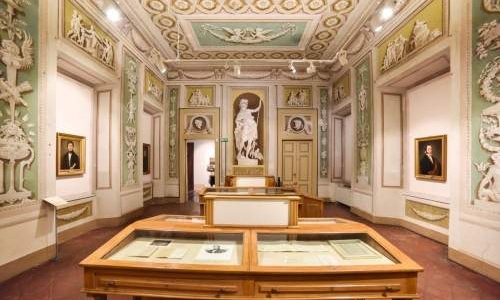
In the Donizettiano Museum in via Arena, there is a collection of memorabilia from Donizetti's life, including letters, family memories, handwritten pages and his wife’s family’s piano, on which he composed his famous arias. The Museum is located at Domus Magna, a crossroads of artists and writers, already home to the music school where Donizetti studied; not far away is Casa Angelini, where he took lessons from Bavarian composer Simone Mayr. At the Accademia Carrara search among the many masterpieces for the painting by Ponziano Loveri, although at the end of his life, the Maestro keeps time with the piano music with one hand.
In the Donizettiano Museum in via Arena, there is a collection of memorabilia from Donizetti's life, including letters, family memories, handwritten pages and his wife’s family’s piano, on which he composed his famous arias. The Museum is located at Domus Magna, a crossroads of artists and writers, already home to the music school where Donizetti studied; not far away is Casa Angelini, where he took lessons from Bavarian composer Simone Mayr. At the Accademia Carrara search among the many masterpieces for the painting by Ponziano Loveri, although at the end of his life, the Maestro keeps time with the piano music with one hand.
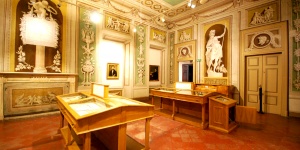
Behind the Santa Maria Maggiore Basilica, follow the silent Via Arena to reach the Domus Magna: here, on the first floor, is the Donizetti Museum.
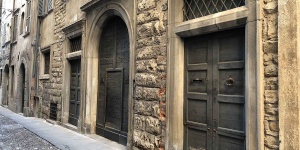
This historic residence dating back to the 1200s and then restored in the second half of the 1900s was, among other things, also the headquarters of the musical institute founded by the Bavarian musician Simone Mayr during the 1800's. It was a charitable training institution, where the poorer citizens could attend classes: it was here, that from 1806 to 1815, the future symbolic composer of Bergamo attended: Gaetano Donizetti.
It is said that the student immediately proved to be very musically gifted, and learned the secrets of composition from masters such as Francesco Salari, Antonio Gonzales and Simone Mayr himself. Did you know that here Donizetti also met Vincenzo Bellini? He then wrote the requiem Mass at his death, but it was only played many years later, in 1870 in the Santa Maria Maggiore Basilica.
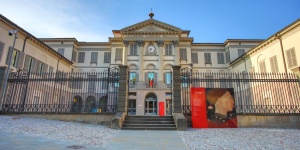
Museum
The Accademia Carrara in Bergamo is a museum with a specific and, in some ways, unique identity, closely tied to its origins and history. Unlike many Italian museums, Carrara is the result of the ambitious project of Giacomo Carrara (1714-1796) to promote the establishment of a cultural institution that would combine pleasure and education, serving as both an art gallery and a painting school. The success of this idea is evidenced by the extensive series of large and small donations made over more than two centuries by individuals and institutions. These, along with a few targeted acquisitions, have complemented the original foundation laid by the founder. Besides Carrara, leading the long list of donors are notable figures such as Guglielmo Lochis, Giovanni Morelli, Federico Zeri, and Mario Scaglia. Their collections form the backbone of the museum and contribute to defining the diverse and articulated character of its heritage.
The renewed visitor's journey is organized in 16 differently-sized rooms, showcasing a total of 350 exhibited works, including paintings, sculptures, medals, and plaques. Visitors thus have the opportunity to embark on a five-century journey through the history of Italian art, from the Renaissance to the nineteenth century, encountering masterpieces by Pisanello, Mantegna, Botticelli, Raphael, Titian, Lotto, Moroni, Hayez, and Pellizza da Volpedo.